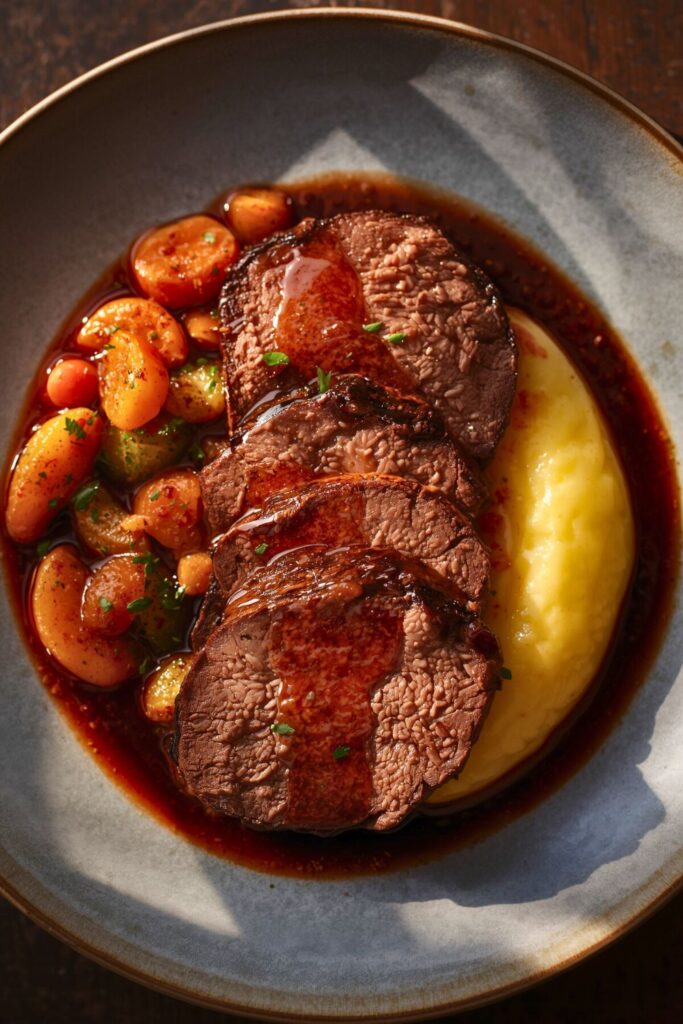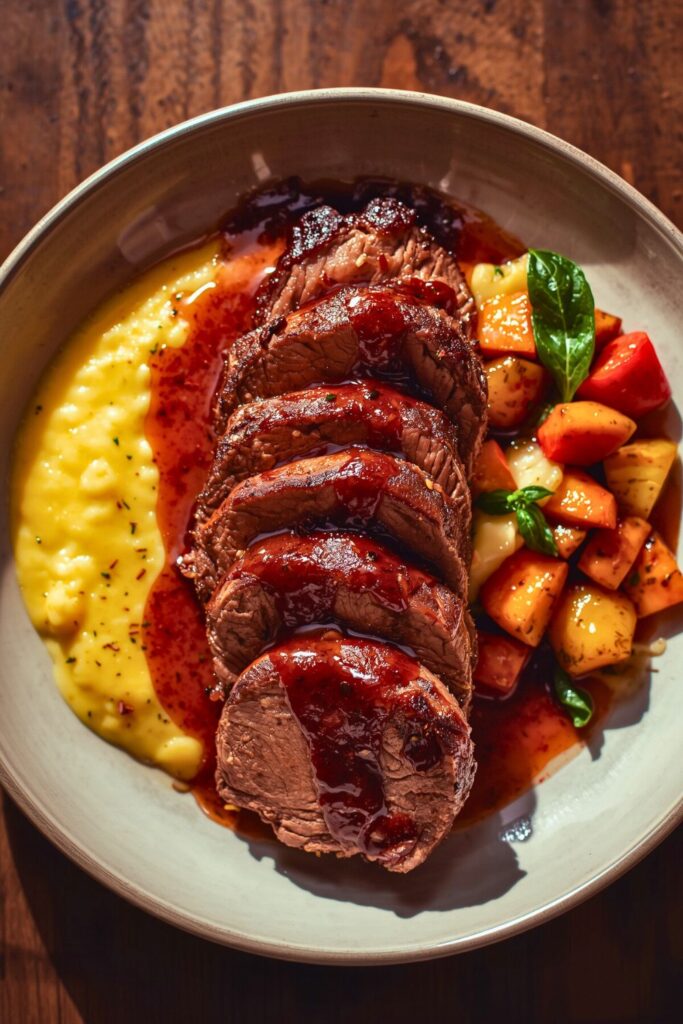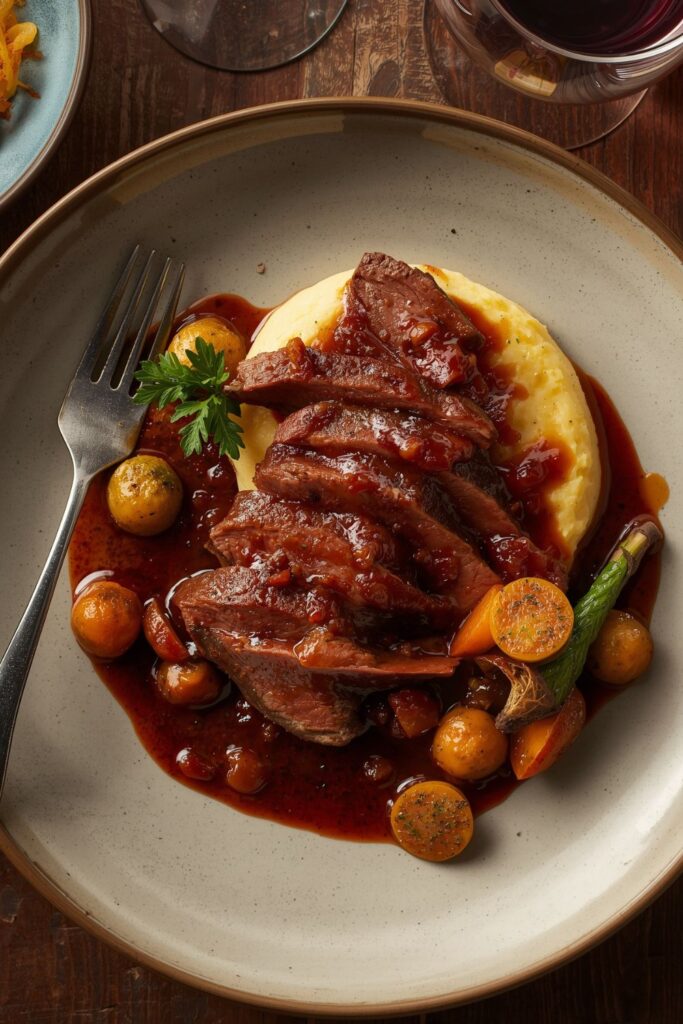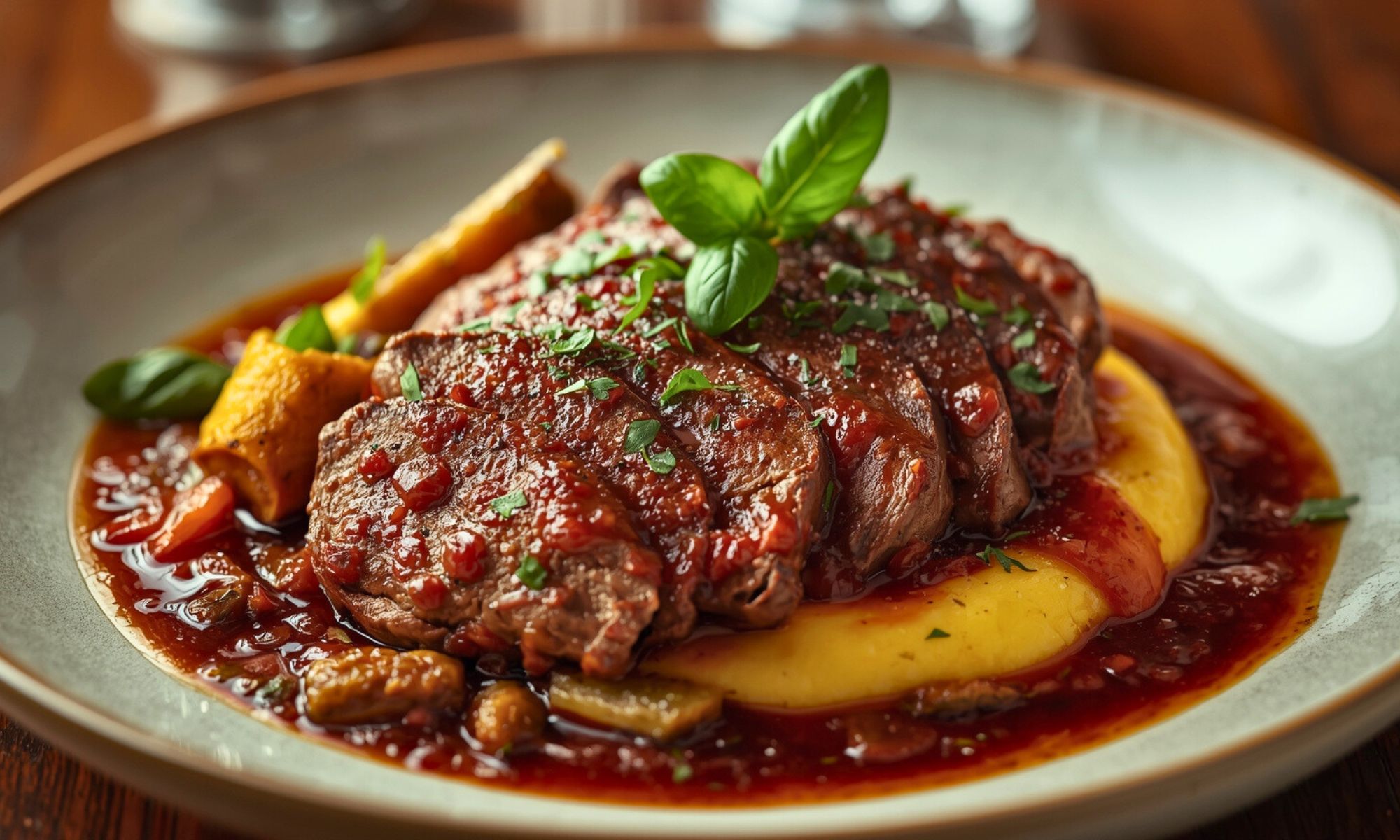You’re halfway through the week, running on caffeine and deadlines, when dinner sneaks up like a calendar reminder you didn’t set. Takeout? Tempting. Leftovers? Already boring. What you really want is something that feels grounding, something that makes the chaos pause without demanding five hours of prep.
That’s where this Italian style braised brisket comes in. I didn’t plan it like a chef on a cooking show, no color-coded mise en place here. Just me, a heavy pot, the last splash of red wine, and a brisket begging to be transformed. The garlic hit the oil, the onions softened down, and suddenly the kitchen smelled like it had been waiting all day for this exact moment.
The payoff? Beef so tender it practically melts into its own tomato-herb sauce, with flavors that hit bold, rustic, and comforting all at once. It’s not fussy, it’s not staged, it’s real food that turns a weeknight scramble into something worth slowing down for.
Keep reading, and I’ll walk you through every step, from browning the brisket like a pro to building a sauce that makes you forget the stress that led you here. Trust me: once you’ve tasted this, you’ll add it to your forever rotation.
Why This Italian Style Braised Brisket Changes Everything

Here’s what most people get wrong about braising brisket, they think it’s all about time. Sure, time matters, but it’s really about building a foundation of flavors that’ll make your guests wonder if you’ve been secretly taking cooking classes in Bologna.
The Italian approach starts with something called soffritto, that holy trinity of diced onions, carrots, and celery that forms the backbone of so many Italian dishes. But here’s the kicker: we’re not just throwing these vegetables in a pot and calling it a day. We’re coaxing out their sweetness, letting them caramelize just enough to create this deep, complex base that’ll make your brisket taste like it’s been simmering in heaven.
Then there’s the wine situation. Italians don’t mess around with cooking wine, they use something they’d actually drink. That Chianti or Sangiovese you’ve been saving? This is its moment to shine.
The Secret Behind Perfect Braised Brisket
What makes this method absolutely foolproof is understanding how collagen breaks down. That tough brisket you’re starting with is loaded with connective tissue that most people see as the enemy. But we’re gonna turn it into our best friend.
See, when you braise low and slow, that collagen melts into gelatin, creating this silky, rich sauce that coats every fiber of meat. The Italians figured this out centuries ago, and they’ve perfected the art of patience.
Essential Ingredients for Italian Style Braised Brisket
Let me walk you through this ingredient list the way I’d actually use them, in the order that makes sense when you’re cooking, not some random alphabetical mess.
For the Soffritto Base:
- 2 medium yellow onions, diced (about 2 cups)
- 3 large carrots, diced (roughly 1½ cups)
- 3 celery stalks, diced (about 1 cup)
- 4 cloves garlic, minced
- ¼ cup extra virgin olive oil (the good stuff, please)
The Star of the Show:
- 4-5 pound beef brisket (first cut if you can swing it)
- 2 tablespoons kosher salt
- 1 tablespoon freshly cracked black pepper
- 2 tablespoons all purpose flour
Building the Braising Liquid:
- 1 bottle (750ml) dry red wine (Chianti Classico is my go to)
- 1 can (28oz) San Marzano tomatoes, crushed by hand
- 2 cups beef stock (homemade if you’ve got it)
- 2 bay leaves
- 3 sprigs fresh thyme
- 1 sprig fresh rosemary
The Finishing Touch:
- ¼ cup fresh Italian parsley, chopped
- 2 tablespoons fresh basil, torn
- Parmigiano Reggiano for grating
Smart Swaps That Actually Work
Can’t find first cut brisket? Second cut works fine, you’ll just get a bit more fat, which honestly isn’t the worst thing for braising. Just trim it down to about ¼ inch thickness.
No San Marzanos? Regular canned whole tomatoes work, but crush ’em yourself, none of that pre crushed stuff that tastes like paste.
Wine situation got you stressed? Here’s the truth: if you wouldn’t sip it, don’t cook with it. But you don’t need to break the bank either. A decent Montepulciano d’Abruzzo will do just fine.
Living somewhere that fresh herbs cost a fortune? Dried works in a pinch, use about half the amount and add them with the liquid, not at the end.
Step by Step Magic: Mastering Italian Braised Brisket

Getting Your Brisket Ready
Start by pulling that brisket out of the fridge about an hour before cooking. Cold meat in a hot pan is gonna seize up on you, and we want this thing to sear beautifully.
Pat it completely dry, and I mean completely. Any moisture is the enemy of a good sear. Season generously with salt and pepper, then dust lightly with flour. This isn’t about making it thick and gloppy; you just want enough flour to help with browning and eventually thicken your braising liquid.
The Searing Step That Changes Everything
Heat that olive oil in your heaviest Dutch oven until it shimmers. You’ll know it’s ready when a drop of water sizzles and evaporates immediately.
Gently lay the brisket in fat side down first. Don’t move it, don’t peek, don’t panic when it starts smoking a little. Let it develop that gorgeous brown crust for about 4-5 minutes. Flip it once and give the other side the same treatment.
Here’s a trick my Italian cooking teacher taught me: the meat will tell you when it’s ready to flip. It’ll release easily from the pan when that crust forms. If you’re fighting it, give it another minute.
Remove the brisket to a plate and don’t you dare clean that pan. All those brown bits stuck to the bottom? That’s liquid gold, and we’re gonna use every bit of it.
Building Your Soffritto Foundation
Drop the heat to medium and add your diced vegetables to the same pan. This is where patience pays off big time. You want these vegetables to soften and start caramelizing, which takes about 8-10 minutes of gentle stirring.
The onions should turn golden and smell sweet. The carrots will start to soften at the edges. The celery loses that raw bite. When you add the garlic, give it just 30 seconds, garlic burns fast and bitter garlic ruins everything.
The Wine Moment
Pour in that beautiful wine and watch it bubble up dramatically. Use a wooden spoon to scrape up all those browned bits from the bottom of the pan. This is called deglazing, and it’s where a lot of your flavor lives.
Let the wine simmer and reduce by about half. You’ll smell the alcohol cooking off, and the liquid will get slightly thicker and more concentrated. This takes about 5-7 minutes.
Bringing It All Together
Add your crushed tomatoes, beef stock, bay leaves, thyme, and rosemary. Nestle that beautiful brisket back into the pot, it should be mostly submerged but don’t worry if a bit peeks out.
Bring everything to a gentle simmer, then cover and slide it into a 325°F oven. Here’s where the magic happens, but it takes time, about 3 to 4 hours depending on the size of your brisket.
You’ll know it’s done when you can shred it easily with a fork, but it’s not falling apart completely. The internal temperature should hit around 195°F to 205°F.
The Science Behind Perfect Braising

Let me explain what’s actually happening in that Dutch oven while you’re waiting. Braising is basically controlled destruction, you’re breaking down tough muscle fibers and connective tissue through moist heat and time.
That brisket starts out tough because it comes from the chest of the cow, a hardworking muscle full of collagen. But here’s the beautiful part: collagen breaks down into gelatin at around 160°F, creating that silky, rich texture we’re after.
The acidic wine and tomatoes help speed this process along while adding incredible depth of flavor. The low oven temperature ensures even, gentle cooking that won’t dry out the meat.
Why This Method Works Better Than Others
Traditional American braising often relies heavily on liquid, which can dilute flavors. The Italian approach uses just enough liquid to create steam and prevent burning, but not so much that you lose that concentrated, intense flavor.
That initial searing step isn’t just for looks, it’s creating hundreds of new flavor compounds through the Maillard reaction. Those brown bits that form? They’re packed with umami that’ll season your entire braising liquid.
The soffritto technique builds layers of sweetness that balance the acidity of the wine and tomatoes. It’s not just vegetables, it’s the foundation of flavor that makes this dish sing.
Making Your Italian Style Braised Brisket Restaurant Beautiful
When that timer goes off and your kitchen smells like an Italian dream, resist the urge to dive in immediately. Let the brisket rest in its cooking liquid for about 15 minutes, this helps it reabsorb some of those incredible flavors.
Carefully transfer the brisket to a cutting board and slice against the grain. This is crucial, cutting with the grain gives you chewy, stringy meat. Against the grain gives you tender, pull apart perfection.
Strain that braising liquid through a fine mesh sieve and taste it. It should be rich, complex, and balanced. If it seems too thin, simmer it on the stovetop for a few minutes to concentrate the flavors.
Plating Like a Pro
Arrange slices of brisket on warmed plates, cold plates cool down food fast, and nobody wants lukewarm brisket. Spoon that gorgeous braising sauce over and around the meat.
Finish with a sprinkle of fresh herbs and a light dusting of grated Parmigiano Reggiano. The cheese adds a salty, nutty note that plays beautifully with the rich meat and acidic sauce.
Perfect Pairings That Complete the Meal
This brisket begs for something starchy to soak up that incredible sauce. Creamy polenta is traditional and perfect, it’s like edible velvet under that rich meat. But honestly, good mashed potatoes or even buttered egg noodles work beautifully too.
For vegetables, keep it simple. Roasted root vegetables echo the flavors in your soffritto, or try some sautéed greens like spinach or Swiss chard for a fresh contrast.
Wine wise, pour the same bottle you cooked with. If it’s good enough for your brisket, it’s good enough for your glass.
Mastering the Art of Italian Braising

This Italian Style Braised Brisket isn’t just dinner, it’s your introduction to one of cooking’s most rewarding techniques. Once you understand how to build flavors through browning, soffritto, and slow braising, you’ve got a skill that’ll serve you for life.
The beauty of this recipe lies in its forgiving nature. Miss the timing by 30 minutes? No problem, braising is almost impossible to overcook. Want to make it a day ahead? Even better, braised meats always taste better the next day after the flavors have had time to meld.
Don’t be afraid to make this recipe your own. Add some orange zest for brightness, or throw in a piece of Parmigiano rind while it braises for extra umami depth. The technique stays the same, but the flavors can dance to your personal taste.
Remember, great cooking isn’t about following rules perfectly, it’s about understanding why those rules exist and then making them work for you. This Italian Style Braised Brisket is your playground for developing that intuitive cooking sense that separates good home cooks from great ones.
Frequently Asked Questions
Can I make Italian Style Braised Brisket ahead of time?
Absolutely, and honestly, it’s even better when you do! Make it up to two days ahead and store it in the refrigerator in its braising liquid. The flavors develop and deepen overnight, and reheating is a breeze. Just warm it gently on the stovetop, adding a splash of stock or wine if the sauce seems too thick.
What’s the best cut of brisket for braising?
First cut (also called flat cut) is ideal because it’s leaner and slices more evenly, but don’t stress if you can only find second cut (point cut). The second cut has more fat and marbling, which actually makes for incredibly rich braising. Just trim excess fat to about ¼ inch thickness before cooking.
My braising liquid seems too thin, how do I fix it?
Easy fix! Remove the brisket and keep it warm, then simmer the liquid uncovered on the stovetop until it reduces and thickens to your liking. You can also whisk in a tablespoon of tomato paste or mix a tablespoon of flour with cold water to create a slurry and whisk it in. The flour you used to dust the brisket should naturally thicken the sauce as it cooks.
Can I use a slow cooker instead of the oven?
You can, but you’ll miss out on some of that concentrated flavor that oven braising provides. If you must use a slow cooker, definitely do the searing and soffritto steps on the stovetop first, then transfer everything to your slow cooker. Cook on low for 6-8 hours, but keep in mind the texture might be slightly different.
What should I do if my brisket is tough after the recommended cooking time?
Keep cooking! Brisket is done when it’s fork tender, not when the timer says so. Some cuts are thicker or tougher than others. Give it another 30-60 minutes and check again. The internal temperature should reach 195-205°F, and you should be able to shred it easily with a fork. Remember, it’s almost impossible to overcook braised brisket.

Swiftly Captions by Tina Smith — Quick, flavorful food recipes made simple, bringing fresh inspiration to your kitchen every day






